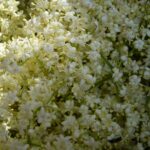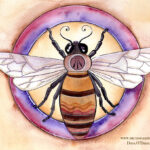Last week, we delved deeply into a critical aspect of land healing with two related concepts; thinking about the world in terms of (eco) systems and the interconnectivity of those ecosystems for all life. Last week was practical, full of discussions, definitions, and how you might design land regeneration projects with ecosystems and interconnectivity in mind. And these things are critical on a physical level: all life depends on other life, all life is connected to other life, and all things great and small are interconnected. Thus, if we want to regenerate the land and engage in physical land healing, understanding and working with these concepts are critical. In addition to last week’s physical work, however, I think it’s really useful to develop ways of exploring these concepts spiritually and ritually. So today’s post takes us a step further and encourages us to explore these connections through ritual and journey-based meditation.

One of the reasons I believe that we should explore these concepts ritually is that human beings, in the 21st century, are living in some of the most disconnected times. It is this disconnection and lack of awareness of the impact activities can make on broader ecosystems that have driven us into the ecological crisis of this age. Rituals, meditation, and other spiritual practices help us better understand possibilities with different kinds of awareness: ritual and meditation practices help us feel through things, not just think about them in an abstract way. They help ground us in them, spark energy with them–in essence, bring the elements together to create a deeper awareness. We as humans have many ways of knowing. Even if we understand these concepts intellectually, it’s important to build wisdom that can only come from experience.
Meditation on Interconnectivity
This first practice is a simple one, and uses a tool called discursive meditation to help you explore interconnectivity. You can use the preliminaries for meditation discussed in this post if you are new to meditation. Go into a natural area, somewhere where nature is fully present. First, begin by observing the world around you, paying attention to how things connect. Where does plant life grow? How does it connect to the water, the sun, the soil, and the light? Spend time simply observing and pondering these connections. Once you have done this, close your eyes and envision yourself in this landscape. In what ways are you connected to this place? Explore those connections. For example, you are breathing the oxygen that the trees are releasing. You are sitting on the soil where roots grow deep, and so on. Now, envision yourself in the broader web of all life. Recognize that you are, in some way, connected with every living thing. Take time to explore this concept. Finally, to conclude your meditation, visualize the connections between yourself and the broader world as lines of light–see the lines of light between you and the nearest tree, you and the waters, you and the sun, and so forth. Feel those connections strongly present. When you are finished, make an offering to the land.
Web of Life Ritual (Group and Solo)
This original ritual is designed simply as an awareness ritual: helping you as a human living in a very disconnected time to acknowledge, know, and honor the interconnected web of life. I’m offering both solo versions and group versions; you can also feel free to adapt this as needed.
For this ritual, you will need nine strands of different colored ribbons, yarn, or string. Ideally, these will be made from natural materials like cotton, wool, or help. The nine strands represent the following:
- The soil web of life
- The waters of the world
- The animal kingdom
- The plant kingdom
- The fungus and lichen kingdoms
- The fishes, reptiles, and amphibians
- The insect life
- The celestial heavens (sun, moon, stars, comets, asteroids, etc)
- Humanity (save this for last).
You can create as elaborate or as simple of a setup as you want for this ritual. You might set up an altar with materials, etc.
Begin the ritual by opening up a sacred space in whatever means you typically do so (which may involve calling the quarters, establishing a circle or sphere of protection, calling in the elements, and so on).
Next, pick up your bundle of strands and choose the first strand and hold it in your hand. As you hold the strand, speak of the strand, calling those energies into the strand. This should be spontaneous and from the heart. Call forth the local representative for that group, or call on the group globally. After you call them, spend time with that energy. Think about your experiences with it, now it has touched you or you’ve interacted with it.

Here’s an example for the first strand, the soil web of life: Oh soil web of all life. The millions of organisms who breathe life into every handful of soil. Fungal hyphae, nematodes, earth worms, bacteria, protozoa, all of the life that creates the building block of life. Soil is sacred. Soil is life reborn. The soil feeds us, supports us, and when we die, we return to the soil. I honor you, sacred soil web.
Now, envision energy coming into the strand from that which you had called. Once you feel this is complete, move to the next strand, working your way
Save humanity for last, recognizing that despite the fact that we act and treat the world as distinct, we are not distinct or separate from it. We are one. Speak for humanity as interconnected and aware, bringing that energy powerfully into the strand.
Once you have done this with all nine strands, gather up your strands and tie them in a knot at the bottom. As you tie, say, “We are all united in the sacredness of life, tied to this sacred planet and dependent on each other. We are interconnected.”
Now, attach the knot to something that will hold it while you braid it, taking three strands together and braiding them as one. As you braid, say, “Weaving the web of life, weaving the web of spirit. All lives are connected, we are one.” As you braid, envision the ecological web of life, the strands connecting each living thing and each living process.
After you are done, sit with the energies of the ritual for a time, allowing them to settle into you. When you are ready, close out the space. Hang your braid somewhere prominent or sacred to continue to remind you of the connection with all living things.
Web of Life Ritual: Group Variant
This ritual can be done in a group setting. Each person in the group can be assigned one or more strands to speak about. If there are more than 9 people, you can also add more strands to represent other natural features (the winds, the mineral kingdom, the molten core of the earth, etc). Make the strands long enough that after they are braided, each participant can leave with their own segment of the stranded (tied off and knotted individually). During the braiding, you can take turns weaving the strands or you can assign one braider as their part in the ritual. At the end, anywhere you want to cut a part of the strand, tie it off and then cut it so that each person gets a piece of the strand to take home with them.
Healing the Web of Life Ritual
Once you have your braided strand, you can use it as the key focus for various kinds of land healing. Here is a simple ritual using this approach (and feel free to experiment!). You can use this ritual in conjunction with the one above or do this at a different time, as you feel led.
Materials: you will need your strand (previously created) and an herbal blessing oil (recipe for oil here) or incense (something to offer a blessing).
Open up a sacred space in your usual way. As part of your opening, make sure you call forth the power of the elements to assist you in your work; you will need energies other than your own for this ritual.
Pick up your strand, and connect with the energies represented in the strand.
After you have connected with the energies in the strand, bless your strand with herbal oil or incense. Speak to each of the energies, as you feel led. For example, for the soil web of life, you might say, “Soil web of life. I know you are under duress as we lose inches of topsoil every year, and as soil webs are destroyed by chemicals, stripping, and more. I send you healing and light.”
Go through each of the nine strands: the soil web of life; the waters of the world; the animal kingdom; the plant kingdom; the fungus and lichen kingdoms; the fishes, reptiles, and amphibians; the insect kingdom; the celestial heavens; and humanity.
After blessing each strand individually, focus on radiating those energies outward to the greater world. Spend as much time as you need to visualize this firmly.
Finally, spend a few minutes in meditation and quietude, seeing if any insights or messages arise. Alternatively, use a divination system at this time to see what additional healing work should be done.
Close out your space.



[…] via Web of Life Ritual for Interconnectivity and Awareness — The Druid’s Garden […]
Hi Friends — it would not receive my comment, so I’ll post it here if I may: —
May we also open a consideration of consciousness, and the purpose of consciousness — since it is, after all, our most abundant and common-denominator, still available — in which to nurture and nourish creative thought in active, rather than passive, meditation? Learning to think is a highly enlightening experience. Love and light, Peter
On Sun, 14 Jul 2019 at 13:34, The Druid’s Garden wrote:
> Dana posted: “Last week, we delved deeply into a critical aspect of land > healing with two related concepts; thinking about the world in terms of > (eco) systems and the interconnectivity of those ecosystems for all life. > Last week was practical, full of discussions, defi” >
Deat Druids — is there a reply to my previous response please?
________________________________
Reblogged this on Good Witches Homestead.
Reblogged this on ravenhawks' magazine.
Whatever evolved us successfully, from conception to birth, is the only thing that can complete the work of evolving our minds and emotional realm to maturity. Unfortunately, that process has been delayed, or arrested, by the human mind as and when it became self-active. The limitations that are set in place by self-activity – attempting to lead life, instead of follow life in co-creative participation – was described in chapter 2 of Genesis, by the activity of a rogue-element of the Crowning Creation who usurped the creative process established successfully, and completed in chapter one, over six Day-Ages, or half of the First Universal Age.
________________________________
Ideally, these will be made from natural materials like cotton, wool, or help.
I assume you meant “hemp”, but the typo is amusing 🙂
I am having some trouble with your assignment of the strands, though. First that fishes, reptiles, amphibians, and insects are all animals; but maybe “animal kingdom” should be read as “mammals and birds”. But then, since humans are animals as well, it seems odd to give them their own strand – especially when this ritual is about how humans are not actually somehow separate from other life?
Yes, the typo is indeed amusing! I think you are right–I was using “animal” more broadly than I should. Thanks for that suggestion!
I do think its important to give humans their own strand though. The whole point is seeing the interconnectivity, allowing the humans to be interwoven with others. That’s a powerful act in a ritual setting. I hope that clarification helps!